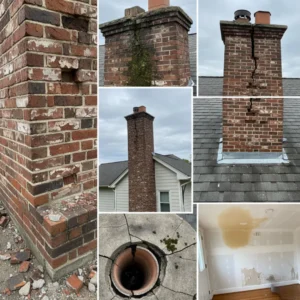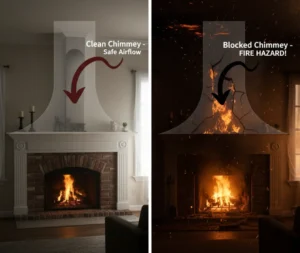When you think about chimney maintenance, your mind likely goes to sweeping creosote or repairing cracked bricks. However, for Houston homeowners, the most frequent and often most critical point of failure is a component you barely notice: the chimney flashing.
Chimney flashing is the unsung hero of your roofline. It’s the thin metal barrier that seals the gap where your chimney brick meets the roof shingles. Its sole, vital purpose is to keep water out of your home. When it fails, the consequences can range from minor ceiling stains to catastrophic structural damage.
At Texas Chimney LLC, we treat flashing maintenance and Chimney Repair with the utmost seriousness. This 1000-word guide will explain the indispensable role of flashing, detail the primary causes of its failure in the Houston climate, and outline why prompt repair is essential for protecting your entire home.
What is Chimney Flashing, and Why is it So Important?
Imagine the chimney as a solid, fixed object extending through a dynamic, moving roofline. As the wood frame of your house and roof expands and contracts with Houston’s temperature swings, a gap naturally opens up between the chimney masonry and the roofing materials.
Chimney flashing is the flexible, layered metal system designed to bridge this gap, maintaining a watertight seal despite the constant movement.
The Two Critical Layers of Flashing
Professional flashing is never a single piece of metal. It is a two-part system designed for maximum redundancy and protection:
- Step Flashing: These are L-shaped pieces of metal tucked underneath the roof shingles and bent up against the side of the chimney. They work together, laid in overlapping layers to ensure that any water running down the roof is directed over the next piece and away from the chimney base.
- Counter Flashing (or Cap Flashing): This metal layer is embedded into the mortar joints of the chimney itself (or secured directly to the masonry) and then folded down to cover the top edge of the step flashing. This counter layer protects the seam where the step flashing meets the chimney wall, essentially providing a durable, weatherproof shield over the entire joint.
The Role: Without this two-tiered system, water would run straight down the chimney face and pour directly into your attic, causing untold damage.
The Top 4 Reasons Flashing Fails in Houston, TX
In the unique climate and construction environment of the Greater Houston area, chimney flashing is under constant assault. Here are the most common reasons we are called out to fix flashing issues:
1. Houston’s Extreme Temperature Swings (Thermal Cycling)
This is the number one enemy of flashing integrity. The cycle of high-heat days followed by cooler nights, especially in the transition seasons, causes the metal and the adjacent roofing materials to expand and contract at different rates.
Metal Fatigue: Over time, this constant movement fatigues the metal flashing, leading to tiny fractures or warps.
Sealant Failure: More commonly, the movement stresses the sealants (like caulk or roof cement) used where the counter flashing meets the mortar, causing them to crack, separate, and break the waterproof barrier.
2. High Winds and Severe Storms
Houston is no stranger to strong winds, hailstorms, and torrential downpours.
Lifting and Tearing: High winds can catch the edges of the flashing, especially poorly installed or old, brittle material, causing it to lift, bend, or tear entirely away from the chimney.
Debris Damage: Falling limbs or heavy hail can physically dent or puncture the flashing, creating a direct path for water. Once a breach occurs, the relentless Houston rain finds its way in immediately.
3. Improper Installation (The DIY or Subpar Contractor Effect)
Flashing installation is a precise, layered process that requires specialized metalworking and masonry skills. This is not a task for an inexperienced roofer or a DIY weekend.
Missing Counter Flashing: The most common mistake is skipping the counter flashing or failing to cut it into the mortar joints, relying only on sealant. Sealants are temporary; cutting the counter flashing into the mortar (called “re-grinding”) creates a permanent mechanical seal that lasts decades.
Poor Overlap: If the step flashing layers are not correctly overlapped, or if they are installed in reverse order, water will inevitably find its way underneath the shingles and into the house.
4. Rust and Corrosion
If the flashing material used is low-quality galvanized steel or simply old and nearing the end of its lifespan, it will eventually rust.
Pinhole Leaks: Rust creates pinholes that allow water to slowly seep in. Once rust begins, it spreads quickly, compromising the entire barrier. For long-term protection in Houston’s high-moisture environment, copper or stainless steel flashing is highly recommended due to their superior resistance to corrosion.
The Serious Consequences of Failing Flashing
When flashing fails, the results are rarely confined to the chimney itself. Water infiltration through this critical area can lead to major, costly damage throughout your home.
1. Attic and Ceiling Damage
The most immediate and common sign of flashing failure is water staining on the ceiling or walls near the fireplace or chimney line. This indicates that water is bypassing the seal, flowing down the chimney chase, and dripping onto the drywall or framing. If you see efflorescence (white, powdery stains) on the chimney’s exterior brick, it is a sign of water ingress, often caused by flashing failure, that has been there long enough to pull salts from the masonry.
2. Rotting Structural Framing
Water that enters the attic saturates the wooden structure of the roof and chimney chase. This creates the perfect environment for wood rot, weakening the structural integrity of your home and potentially leading to the growth of toxic mold and mildew. Repairing rotted wood framing around a chimney is often the most expensive part of a flashing failure repair.
3. Chimney Liner Deterioration
When water gets past the flashing, it runs down the inside of the masonry. This moisture accelerates the corrosive properties of creosote and soot inside the flue, causing the flue liner to deteriorate prematurely. A damaged liner is a severe fire hazard and can allow carbon monoxide to seep into your home. A simple flashing fix is vastly cheaper than a full flue relining.
Your Next Step: The Professional Flashing Inspection
Due to its high position and layered nature, chimney flashing is impossible for the average homeowner to inspect properly. If you see any signs of a leak water spots, rust stains, or missing caulk you need immediate, professional attention.
At Texas Chimney LLC, we specialize in precise, long-lasting flashing solutions.
- Diagnosis: We don’t just patch; we get to the root cause of the leak using a comprehensive top-to-bottom Chimney Inspection that checks the entire system.
- Expert Repair: We use high-grade, durable materials and professional re-grinding techniques to ensure the counter flashing is properly seated in the mortar, providing a permanent, watertight seal.
- Comprehensive Solutions: We also check your chimney crown, cap, and nearby roofing components to ensure all layers of your system are working together to keep your home dry. We also handle major structural issues through our Masonry and Repair services if the damage is severe.
Don’t let a small metal strip lead to thousands of dollars in water damage. If you suspect a leak or haven’t had a professional chimney inspection in years, be proactive.
Contact us today to schedule your essential chimney and flashing inspection with Texas Chimney LLC.





